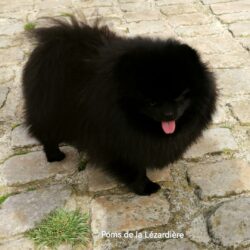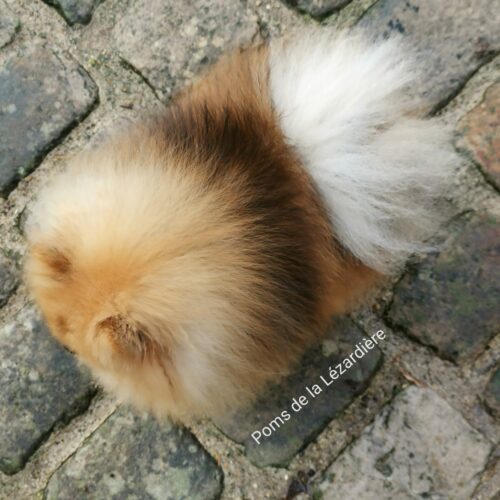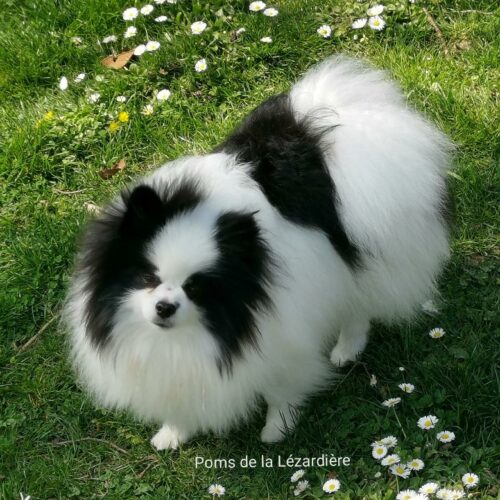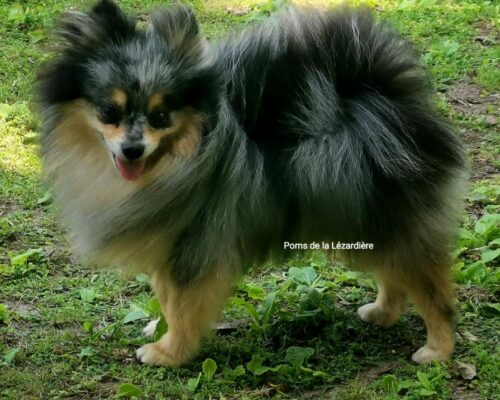
Charcoal Orange

Blue Marbled and Tan

Black and Tan

Wolf

Sand Cream

Black

Black and Tan

Wolf
Dresses in pictures

Dress nomenclature
The colouring of the coat results from the presence of 2 pigments called melanins:
– eumelanin: dark pigment, black or brown colour
– pheomelanin: light pigment, sand to tan colour
In the absence of pigment, white is obtained.
The dresses are classified in :
–simple: contain only one pigment, dark or light, or are completely devoid of it.
black, brown, blue, beige, tan, sand and white.
–composite: coloured by pheomelanin. They are tan if the pigment is normal and sandy if it is diluted. Fawn and sandy colours vary greatly in shade.
fawn or sandy masked, charcoal, brindle, black or chocolate and tan,
–Modified: contains both dark and light pigments but no white at all. They are therefore uniformly coloured and bipigmented. Depending on the distribution of the eumelanin and pheomelanin, five types of coat can be identified, with a number of variations: masked fawn, charcoal fawn, brindle fawn, black fawn and mantled fawn.
grey, variegated, variegated
The different colours
White: the colour is pure white.
Black: The coat, skin and undercoat are pure, solid black.
Orange: orange shading, white patches are tolerated on chest, tail and feet.
Orange-charcoal: orange with dark hair tips (charcoal).
Red: deep rust colour.
Brown: brown is dark and very uniform.
Chocolate: a rich brown.
Wolf grey: also known as ombre grey, wolf grey is a silvery charcoal grey. The tips of the hairs are black. There is a dark marking on the head and eyes. The mane and shoulder hairs are lighter. The legs have no black spots.
Cream: this is a very pale yellow or orange, without any shade of white.
Sand: can have several shades
Sand-orange : must have an orange body, a lighter orange or even creamy undercoat with black tips on the guard hairs.
Black and tan:The base is black, with tan markings on the muzzle, cheeks, eyes, chest and legs.
Bicolore : le fond de la robe est de blanche avec des marques de couleurs réparties sur le corps.
Particolour: bicolour with tan markings.
Blue Marbled: black base colour combined with Marble pattern.
Blue Marbled and Tan : black base colour combined with Marble pattern with fire points.
Blue : diluted black with blue points.
Blue-sand : blue base with dark blue guard hairs and ending again in a black tip on the guard hairs.
Chocolate et Tan : chocolate base colour with tan points.
Chocolate Marbled : chocolate base colour combined with Marble pattern.
Beaver: Colouring ranging from a light biscuit to a darker brownish grey with a silvery blue tinge to the coat.
Brindle black: gold, red or orange base colour with strong black cross-stripes.
Chocolate sand: a chocolate base layer with darker chocolate guard hairs.
Lavender: greyish colour with a pinkish chocolate tinge to the coat.
Blue brindle: basic colour is gold, red or orange with strong blue cross-stripes.
The standard of the French Book of Origins recognizes several colours for the Miniature Spitz such as white, black, orange, brown, sable, wolf-grey, black and tan. The dog can be LOF confirmed.






marbled colour
The marbled gene produces mottled areas of colour in a dog’s coat, can affect the colouring of the skin on the nose and paw pads and produce blue or oddly coloured eyes.
Marbled is a colour combination pattern in dog coats. This is a solid base colour (usually red/brown or black) with lighter blue/grey or reddish patches, giving an uneven marbled or mottled effect.
The coat colour pattern of the marbled gene can appear on any base colour pomeranian. The marbled pattern is usually lighter on a darker pomeranian. Marbled is a dominant gene. Dogs displaying the marbled pattern must have a marbled parent.
Marbled gene also affects eye and skin colour. For example, the eyes may be medium to light brown with indigo spots; a dark, bright sapphire; or a beautiful pale blue.
Beware, never mate 2 carriers of the marbled gene. They will give birth to double-marbled puppies. It is important to know that although the puppies have a very attractive predominantly white coat, they have a very high risk of developing blindness, deafness, malformations and a high mortality risk.
The SCC (Société Centrale Canine) banned these unions in 2017.
Animal Welfare Act: “Mating a marbled with a marbled is breeding under torture and is prohibited”.




Links to learn more
Centrale Canine’s website on coat nomenclature
article published on 14-05-2017
The website of the central canine organisation on the Livre des Origines Françaises LOF
article published on 27-04-2017


